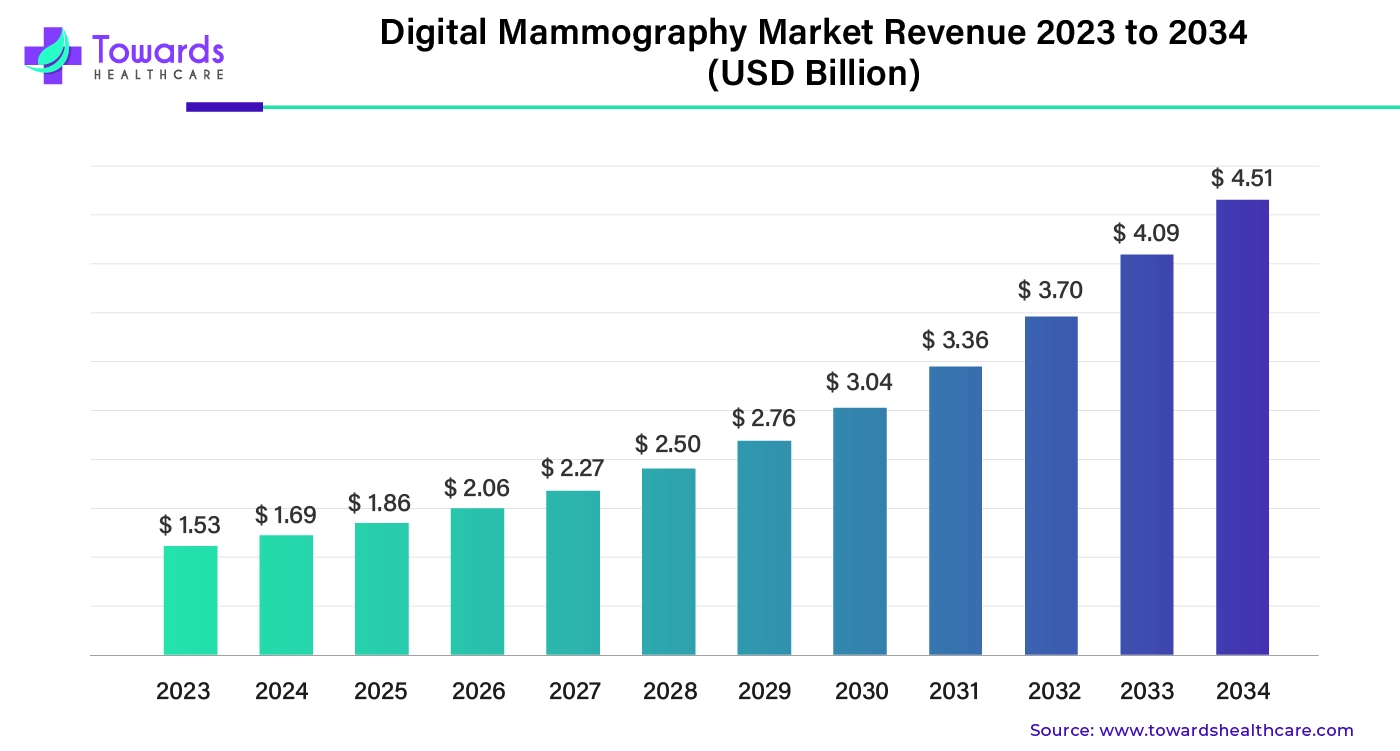April 2025


Principal Consultant

Reviewed By
The digital mammography market was estimated at US$ 1.53 billion in 2023 and is projected to grow to US$ 4.51 billion by 2034, rising at a compound annual growth rate (CAGR) of 10.30% from 2024 to 2034. The rise in breast cancer cases and advancements in technology drive the market.

Mammography is a procedure that examines the breast to look for cancer early on using low-dose X-rays. In digital mammography, also known as full-field digital mammography (FFDM), solid-state detectors that translate X-rays into electrical signals are used in place of X-ray film. On a computer screen, these electrical signals create pictures of the breast that may be reproduced on a certain type of film. These pictures are examined closely for anomalous calcification or dense bulk regions. Direct radiography, computed radiography, and digital breast tomography are the three main forms of digital mammography. As a result, these methods have several advantages, such as improved accuracy, clearer imaging of anomalies within thick breasts, safety from low radiation sources, and early diagnosis of breast malignancies.
The recent advancements in the field of technology, including artificial intelligence (AI), machine learning (ML), and deep convolutional neural network (CNN), have immense potential to revolutionize the digital mammography market. AI algorithms are applied to independently read a mammogram. This reduces the overall workload of breast radiologists while improving screening performance. It can also reduce the time required to interpret diagnostics. Several organizations are developing AI systems for effective interpretation of mammograms. Hence, AI will alter the way radiologists interpret mammograms over the coming decade.
For instance,
| Company Name | GE Healthcare |
| Headquarters | Chicago, Illinois, United States |
| Recent Development | In November 2023, GE Healthcare launched MyBreastAI Suite to facilitate improved breast cancer detection on mammography exams. Studies proved that the new AI platform showed an 8% increase in sensitivity, a 6.9% increase in specificity, and a 52% decrease in reading time. |
| Company Name | Metaltronica, SpA |
| Headquarters | Pomezia, Lazio, Italy |
| Recent Development | In May 2024, Ibex announced the integration of its osteoporosis detection software into Metaltronica’s Cybele digital mammography system. The software is being tested in Addenbrooke’s Hospital, Cambridge, to assess the bone density in post-menopausal women receiving aromatase inhibitors. |
Breast cancer is the second most common cancer worldwide and the most prevalent type of cancer in women globally. According to the WHO, globally, approximately 2.3 million breast cancer cases were reported, with approximately 670,000 deaths in 2022. Apart from women, breast cancer also occurs in around 0.5-1% of men. By 2040, it is expected that the annual global burden will surpass 3 million new cases. Mammography is the only diagnostic tool available for the detection of breast cancer. Digital mammography enables the examination of suspicious areas and improves the ability to detect and diagnose breast carcinoma. It offers numerous advantages over conventional mammography, including faster image acquisition, display, and storage. It also offers better contrast resolution for screening women with dense breasts and breast implants.
The table below demonstrates the incidences of cancer in women in different nations in 2022. The table lists the top eight countries in the world with the highest number of cancer cases and deaths. Hence, the surge in breast cancer cases increases the demand for its diagnosis, thereby potentiating the global market.
| Sr. No. | Countries | Incidence | Deaths |
| 1. | World | 2,296,840 | 666,103 |
| 2. | China | 357,161 | 74,986 |
| 3. | USA | 274,375 | 42,900 |
| 4. | India | 192,020 | 98,337 |
| 5. | Brazil | 94,728 | 22,189 |
| 6. | Japan | 91,916 | 17,638 |
| 7. | Russia | 78,839 | 22,115 |
| 8. | Germany | 74,016 | 20,601 |
The high installation cost of the digital mammography instrument prevents many hospitals and diagnostic centers from installing the equipment, especially in low- and middle-income countries. The average cost of a digital mammography varies from $55,000 to $75,000. Additionally, the advanced mammography machine can cost around $215,000 to $275,000. The technological advancements further tend to increase the initial installation cost of the equipment. Furthermore, the high medical cost of breast cancer globally limits the affordability of the patients.
The growing need for breast cancer diagnosis with accurate and precise results has potentiated numerous advancements in digital mammography. Contrast-enhanced mammography (CEM) has been added to mammography as part of ongoing attempts to improve cancer diagnosis. This allows for a better understanding of whether a lesion of concern is expanding by adding physiological information to morphologic data. CEM has proved to have superior performance than standard mammography for analyzing breast tumors, especially for women of high risk or having dense breasts. CEM can be performed in patients who have contraindications to MRI. Additionally, it has been demonstrated that CEM is less expensive and more accessible than MRI and potentially better tolerated by patients.
For instance,
By product, the 2D full-field digital mammography segment dominated the digital mammography market in 2023. The 2D full-field digital mammography generates 2D X-ray images of the breast. It can take X-rays of the breast from two angles, i.e., from top to bottom and from side to side. A 2D mammogram can detect cancerous growths that are too small to feel, even when there are no signs and symptoms. A 2D mammogram is comparatively cheaper than a 3D mammogram, which increases its preference among patients. A 3D mammogram costs around $50 to $100 more than a 2D mammogram. Hence, the low cost of a 2D mammogram, accurate, detailed images, and favorable insurance policies drive the market.
For instance,
By product, the 3D full-field digital mammography tomosynthesis segment is expected to grow at the fastest rate in the digital mammography market during the forecast period of 2024 to 2034. 3D tomosynthesis is an advanced version of mammography that generates 3D images of the breast. Despite being costlier than 2D mammography, its demand is increasing. A 3D mammogram gives more accurate information about changes in the breast. 3D mammography may be superior to 2D mammography in reducing the likelihood of false positives and the ability to detect tumors in dense breast tissue. According to a 2014 study, 3D mammography can find 20 to 65% more invasive breast cancers than 2D mammography. Hence, these advantages increase the demand for 3D full-field digital mammography tomosynthesis.
For instance,
By end-use, the hospitals segment led the global digital mammography market in 2023. Hospitals provide numerous facilities for patients in a single location. The presence of skilled healthcare professionals and the availability of required space boost the market. It integrates the expertise of several healthcare professionals like radiologists, surgeons, oncologists, and radiation oncologists. The experts provide on-the-spot diagnosis and solutions to the test results.
For instance,
By end-use, the diagnostic centers segment is projected to expand rapidly in the digital mammography market in the coming years. The diagnostic centers provide a wide range of services, including cost-effective and advanced technology. The experts at diagnostic centers provide accurate diagnosis, efficient services, and credible results.
By region, North America held a dominant share of the digital mammography market in 2023. The rising breast cancer cases, increasing investments and collaborations, advanced healthcare infrastructure, increased awareness, and technological advancements drive the market. The US government's latest initiative, the US Preventive Services Task Force, suggests that women aged 40 to 74 with average breast cancer risk should get a mammogram every 2 years.
Additionally, the CDC’s initiatives, like the National Breast and Cervical Cancer Early Detection Program (NBCCEDP), assist uninsured and underinsured women to get access to timely breast and cervical cancer screening and diagnosis services. According to the CDC, the NBCCEDP-funded programs have conducted more than 16.3 million breast and cervical cancer screening exams from 1991 to 2024. Out of these, 78,915 women were diagnosed with invasive breast cancers, and 25,029 women were diagnosed with premalignant breast lesions. The US government supports and grants many other funded programs for early detection and treatment of breast cancer.
By region, Asia-Pacific is anticipated to grow fastest during the forecast period. The increasing prevalence of breast cancer, rising population, increased investments and collaborations, favorable reimbursement policies, presence of key players, and government initiatives drive the digital mammography market. Countries like China, India, and Japan have the highest number of breast cancer cases globally. The Government of India invested INR 21 crores in 2024 in 20 district hospitals to provide digital mammography machines. China’s national cancer screening program provides cervical and breast cancer screening. Also, various awareness campaigns in Japan improve breast cancer literacy and screening.
For instance,
By Product
By End-Use
By Region
April 2025
April 2025
March 2025
March 2025